wimpel69
04-18-2014, 01:11 PM
Sharing on these albums has ended. No more requests and no re-ups, please!
"Andrew Schenck, 51, A Music Director, Dies - Published: February 21, 1992.
Andrew Schenck, the music director of two New York ensembles, the Nassau Symphony Orchestra
and the Atlantic Sinfonietta, died on Wednesday at his home in Baltimore. He was 51 years old.
He died of melanoma, said Marvin Schofer, his former manager.
Mr. Schenck was best known for his performances and recordings of American music, particularly the
works of Samuel Barber. With the New Zealand Symphony Orchestra and the Chicago
Symphony Orchestra and Chorus, he recorded several obscure works by Barber in recent years,
including The Lovers, an orchestral song cycle, and the Second Symphony. His recordings
also include works by Randall Thompson, Paul Hindemith, Kurt Weill and Aaron Copland.
He was born on Jan. 7, 1941, in Honolulu. He studied at Harvard, and privately with Pierre Monteux
and Leonard Bernstein, and he took his Master of Music degree at Indiana State University.
In 1988, he became music director of the Nassau Symphony Orchestra, which performs at Hofstra
University. He became music director of the Manhattan-based Atlantic Sinfonietta in 1989. He was
also the founding music director of the Baltimore Chamber Opera Theater and an associate
conductor of the Baltimore and Honolulu Symphony Orchestras."
New York Times Obit
This collection includes:
Samuel Barber: Symphony No.2, The Lovers, Prayers of Kierkegaard, Essay for Orchestra,
The School for Scandal, Adagio, Souvenirs, Music for a Scene from Shelley
Randall Thompson: Symphony No.2, Symphony No.3
Gian Carlo Menotti: Amahl and the Night Visitors (Suite), Sebastian (Suite)
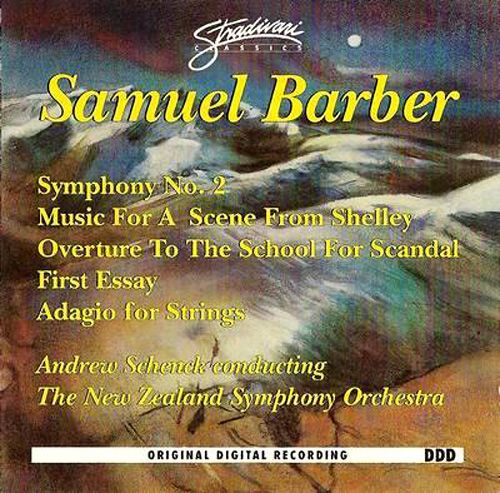
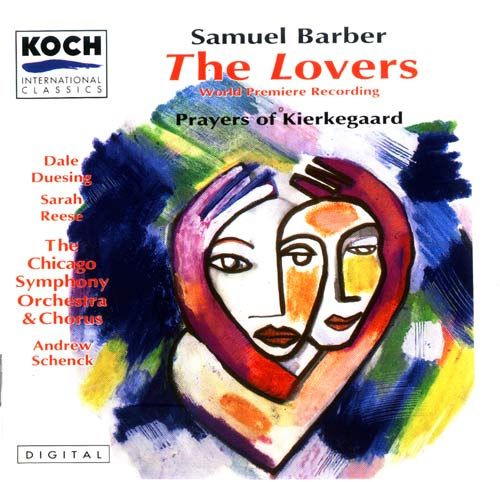
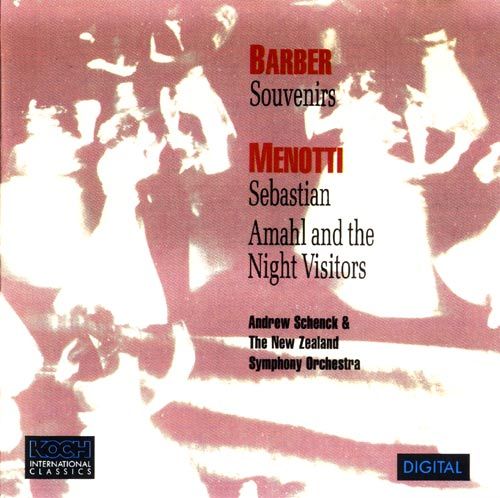
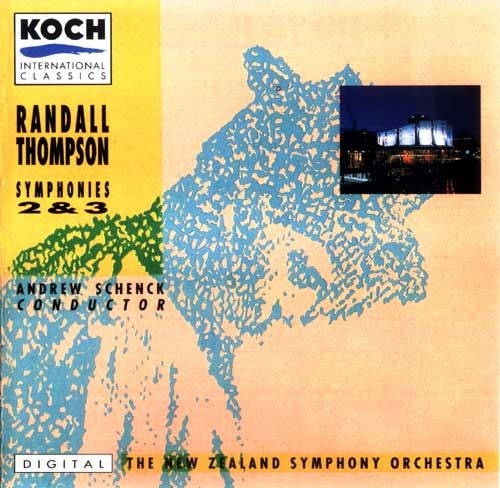
Music Composed by
Samuel Barber
Gian Carlo Menotti
Randall Thompson
Played by the
New Zealand Symphony Orchestra
Chicago Symphony Orchestra
With
Dale Duesing (baritone)
Sarah Reese (soprano)
And the
Chicago Symphony Chorus
Conducted by
Andrew Schenck
"But it is The Lovers (1970), his most audacious work, that is a frank exposure of his undisguised feelings.
The cool Barber here exposes a cauldron of emotion, bordering on the world of Menotti — "Love has a bitter
core, Vanessa." It is a prime example of Barber’s ability to fine-tune the sensuous appetites — either
restrained or demonic — an ability that gives so much of his work its power and immediacy.
Barber was tremendously amused at the controversy aroused by the erotic text of the Neruda poems he
set in The Lovers. (It was suggested to him by Valentin Herranz.) Some members of the Girard Bank that
commissioned the work were not amused. When he asked them "whether they still have love affairs in
Philadelphia" he won his case."
"Prayers of Kierkegaard is unequivocally a religious statement. Here the no-nonsense realistic-yet-hopeful
attitude of American Protestantism, the nucleus of Barber’s upbringing, has found a center. He wrote,
in discussing the work: "One finds here three basic truths(:D imagination, dialectic, and religious melancholy.
The truth he [Kierkegaard] sought after was a truth which was a truth for me." Can any definition of a
faith be clearer?"
"So I had no qualms about buying the New Zealand Symphony Orchestra's accounts of the American
composer Randall Thompson's three symphonies. This is a double-disc set recorded in 1997, sold for
the price of one CD on the Koch International Classics label. The New Zealand Symphony Orchestra
is in fine form on these recordings.
Symphony No. 2: Thompson's second symphony is also his second of 1931, apparently a very good
year for him. He goes with the classical format of a four-movement symphony this time, though once
again the movements are nicely balanced. The Allegro is propelled by strong rhythms, once again like
a symphony for dancers. As with the No. 1, there is a powerful sense of motion - I can almost see
the music cavorting. The second movement, Largo, is all adjective if the first was all verb. It has a
suggestion of Delius. Third movement: The rhythm with which this movement opens suggests to me
the Symphony No. 1 of William Walton, which the Thompson work precedes by a few years. Then
follows another Delius-like interlude (Disc 1, Track 6, 2: 15), which eases the tension before the
rhythm storms back into place. Again, abstractly it suggests a tug of war between verb and adjective.
The last movement, marked Andante moderato, might make this the most American of Thompson's
works. Once again I had the sense of Delius - but this time Delius when he is writing in his American
vein. I thought of his Florida Suite. The humming close of this symphony is one of the passages that
brings home to me the vocal quality of Thompson's writing for orchestra.
Symphony No. 3: There are passages in the first movement of this symphony that remind me of the
Portuguese composer, Joly Braga Santos, in his wonderful Symphony No. 2 (which, coincidentally,
also is written in 1947, the same year in which Thompson is setting to work on this, his last symphony).
The first movement of the Thompson No. 3 is marked Largo elegiaco, and perhaps it's the elegiac
nature of both that appeals to me. (In the Braga Santos No. 2, it's this quality that I hear in the Adagio,
and again in the very start of the fourth movement, marked Lento.). The second movement, Allegro
appassionato, is one of those passages that cries out for singing. It's built on such strong rhythms,
all that's needed is the voices to make it seem straight out of Carmina Burana. The third movement is
marked Lento tranquillo. To my mind, it holds some of the same folk-like quality as the last movement
of the Dvorak's Symphony No. 9. Thompson wraps up the work with a quick finale - just under 5 minutes
in this account - marked Allegro vivace. Here, it is as though Thompson's American music has vaulted
back to the old world - it is the playing of the flutes, with an almost Celtic puckishness and charm,
that wins the listener. Just as in the second movement, it's music that will make your toes start tapping -
but perhaps a little more quietly as the work plays out."
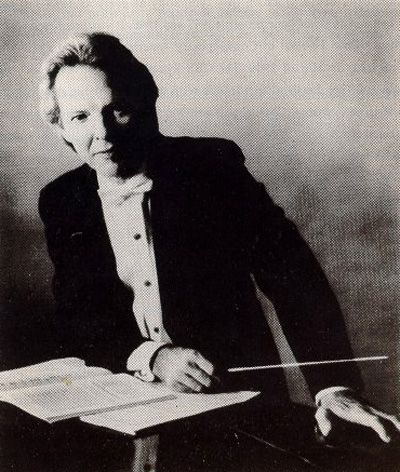
Sharing on these albums has ended. No more requests and no re-ups, please!
"Andrew Schenck, 51, A Music Director, Dies - Published: February 21, 1992.
Andrew Schenck, the music director of two New York ensembles, the Nassau Symphony Orchestra
and the Atlantic Sinfonietta, died on Wednesday at his home in Baltimore. He was 51 years old.
He died of melanoma, said Marvin Schofer, his former manager.
Mr. Schenck was best known for his performances and recordings of American music, particularly the
works of Samuel Barber. With the New Zealand Symphony Orchestra and the Chicago
Symphony Orchestra and Chorus, he recorded several obscure works by Barber in recent years,
including The Lovers, an orchestral song cycle, and the Second Symphony. His recordings
also include works by Randall Thompson, Paul Hindemith, Kurt Weill and Aaron Copland.
He was born on Jan. 7, 1941, in Honolulu. He studied at Harvard, and privately with Pierre Monteux
and Leonard Bernstein, and he took his Master of Music degree at Indiana State University.
In 1988, he became music director of the Nassau Symphony Orchestra, which performs at Hofstra
University. He became music director of the Manhattan-based Atlantic Sinfonietta in 1989. He was
also the founding music director of the Baltimore Chamber Opera Theater and an associate
conductor of the Baltimore and Honolulu Symphony Orchestras."
New York Times Obit
This collection includes:
Samuel Barber: Symphony No.2, The Lovers, Prayers of Kierkegaard, Essay for Orchestra,
The School for Scandal, Adagio, Souvenirs, Music for a Scene from Shelley
Randall Thompson: Symphony No.2, Symphony No.3
Gian Carlo Menotti: Amahl and the Night Visitors (Suite), Sebastian (Suite)




Music Composed by
Samuel Barber
Gian Carlo Menotti
Randall Thompson
Played by the
New Zealand Symphony Orchestra
Chicago Symphony Orchestra
With
Dale Duesing (baritone)
Sarah Reese (soprano)
And the
Chicago Symphony Chorus
Conducted by
Andrew Schenck
"But it is The Lovers (1970), his most audacious work, that is a frank exposure of his undisguised feelings.
The cool Barber here exposes a cauldron of emotion, bordering on the world of Menotti — "Love has a bitter
core, Vanessa." It is a prime example of Barber’s ability to fine-tune the sensuous appetites — either
restrained or demonic — an ability that gives so much of his work its power and immediacy.
Barber was tremendously amused at the controversy aroused by the erotic text of the Neruda poems he
set in The Lovers. (It was suggested to him by Valentin Herranz.) Some members of the Girard Bank that
commissioned the work were not amused. When he asked them "whether they still have love affairs in
Philadelphia" he won his case."
"Prayers of Kierkegaard is unequivocally a religious statement. Here the no-nonsense realistic-yet-hopeful
attitude of American Protestantism, the nucleus of Barber’s upbringing, has found a center. He wrote,
in discussing the work: "One finds here three basic truths(:D imagination, dialectic, and religious melancholy.
The truth he [Kierkegaard] sought after was a truth which was a truth for me." Can any definition of a
faith be clearer?"
"So I had no qualms about buying the New Zealand Symphony Orchestra's accounts of the American
composer Randall Thompson's three symphonies. This is a double-disc set recorded in 1997, sold for
the price of one CD on the Koch International Classics label. The New Zealand Symphony Orchestra
is in fine form on these recordings.
Symphony No. 2: Thompson's second symphony is also his second of 1931, apparently a very good
year for him. He goes with the classical format of a four-movement symphony this time, though once
again the movements are nicely balanced. The Allegro is propelled by strong rhythms, once again like
a symphony for dancers. As with the No. 1, there is a powerful sense of motion - I can almost see
the music cavorting. The second movement, Largo, is all adjective if the first was all verb. It has a
suggestion of Delius. Third movement: The rhythm with which this movement opens suggests to me
the Symphony No. 1 of William Walton, which the Thompson work precedes by a few years. Then
follows another Delius-like interlude (Disc 1, Track 6, 2: 15), which eases the tension before the
rhythm storms back into place. Again, abstractly it suggests a tug of war between verb and adjective.
The last movement, marked Andante moderato, might make this the most American of Thompson's
works. Once again I had the sense of Delius - but this time Delius when he is writing in his American
vein. I thought of his Florida Suite. The humming close of this symphony is one of the passages that
brings home to me the vocal quality of Thompson's writing for orchestra.
Symphony No. 3: There are passages in the first movement of this symphony that remind me of the
Portuguese composer, Joly Braga Santos, in his wonderful Symphony No. 2 (which, coincidentally,
also is written in 1947, the same year in which Thompson is setting to work on this, his last symphony).
The first movement of the Thompson No. 3 is marked Largo elegiaco, and perhaps it's the elegiac
nature of both that appeals to me. (In the Braga Santos No. 2, it's this quality that I hear in the Adagio,
and again in the very start of the fourth movement, marked Lento.). The second movement, Allegro
appassionato, is one of those passages that cries out for singing. It's built on such strong rhythms,
all that's needed is the voices to make it seem straight out of Carmina Burana. The third movement is
marked Lento tranquillo. To my mind, it holds some of the same folk-like quality as the last movement
of the Dvorak's Symphony No. 9. Thompson wraps up the work with a quick finale - just under 5 minutes
in this account - marked Allegro vivace. Here, it is as though Thompson's American music has vaulted
back to the old world - it is the playing of the flutes, with an almost Celtic puckishness and charm,
that wins the listener. Just as in the second movement, it's music that will make your toes start tapping -
but perhaps a little more quietly as the work plays out."

Sharing on these albums has ended. No more requests and no re-ups, please!